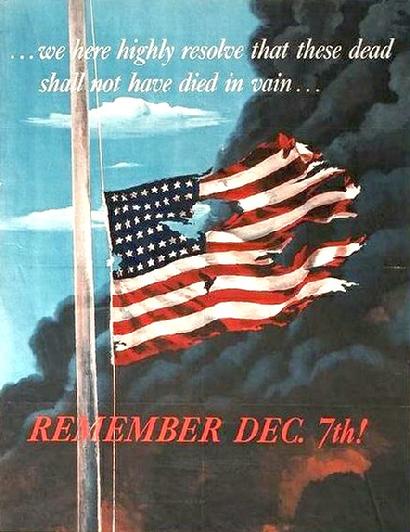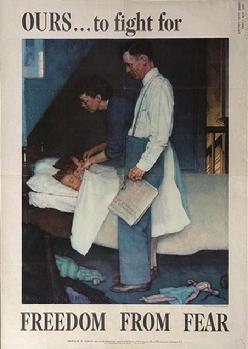|
December 7, 1941
U.S. Attacked!
Enters Second World War
Hamden Fire Department Prepares for the Worst
|
 |
| The New Haven Sunday Register "EXTRA" published the evening of Sunday December 7, 1941. CLICK to enlarge |
|
|
 |
| WWII War Bond Poster (Image courtesy of Chick Manware) |
|
|
Seventy years ago, on Sunday, December 7, 1941, the Japanese surprise attack on Pearl Harbor triggered America's entry into World War II. In his address to Congress the following day, President Franklin Roosevelt asserted that we would "gain the inevitable triumph." Three years and eight months later we did.
|
 |
| Norman Rockwell's iconic "Freedom From Fear," one of the Four Freedoms that he illustrated during WWII |
|
The
country was unified after Pearl Harbor. In the first few days, tens of
thousands of young men swarmed local recruiting stations to join in the
fight. From the beginning until V-J day, Americans were focused on
supporting our men in the armed forces and defending the U.S. homeland
against a Juggernaut of vicious and determined enemies.
Still
under the leadership of volunteer officers at the time of the attack,
Hamden's paid and volunteer firefighters began preparing for the worst, with training sessions on air raids and bombings. The Red Cross
provided first-aid courses. A call went out among the Hamden citizenry for "auxiliary firemen" to supplement the volunteer and paid manpower in the event of an air raid.
Well
into 1942, some Hamden volunteer
fire companies manned their stations each night, making them immediately available to the paid forces in the event of an emergency. An excerpt from from Mt. Carmel's meeting minutes of March 12, 1942: "All
volunteers for night services at the firehouse are to give their names
to [volunteer] Capt. [Francis] Leddy, who will arrange groups of four
with a given Lieut in charge of his shift."
The Hamden
Fire Department was reorganized in April 1942. The Board of Fire
Commissioners conducted examinations to determine the department's first
full-time officers. Raymond C. Spencer was appointed as Hamden's first
paid fire chief. The department's first paid line officers, Capt.
Joseph Hromadka, Capt. Al Purce, Lieut. Everett Doherty and Lieut.
Roland Ruwet, were promoted from the ranks of the paid firefighters. Line personnel now numbered two officers and ten firefighters on each of two platoons.
|
(Not pictured:
Mario “Bucky” Serafino, Ed Kromer and V. Paul Leddy. Leddy had joined
the department five weeks before Pearl Harbor and was on leave from the department for service
in the armed forces.)
|
 |
| 1941 Diamond-T Ladder Truck |
|
Most
Hamdenites today are probably not aware that Winchester's powder farm
on Putnam Avenue made Hamden a potential military target. Given the
limitations of enemy aircraft at the time, however, sabotage was a far
more plausible threat than an enemy air raid. Nonetheless, the
potential existed and some Hamden residents near the powder farm feared
enemy incendiary bomb attacks.
The
war put many orders for new fire apparatus on hold, with essential wartime priorities going to larger communities and the military. But Hamden had
placed its orders for a new ladder truck and pumper with the Woods
Engineering Service of Topsfield, Massachusetts well before December
7th.
The new apparatus was delivered in early 1942.
On February 11, a new 1941 Diamond-T city service ladder truck was placed in
service at the
Highwood station, replacing the 1926 Maxim ladder truck that was
demolished when hit by a trolley car the previous year. Two months
later, a new Diamond-T
600 g.p.m. pumper was placed in service as Engine 1 at the
Highwood station. The
1926 Maxim 500 g.p.m. pumper that had been Engine 1 since new was
transferred to the Merritt Street station to replace Co. 6's 1924 Stutz
350 g.p.m. pumper.
|
|
Later in 1942, Hamden acquired some unique additions to the department's firefighting inventory. Maxim manufactured something called a "Blitz Buggy," a gasoline powered 500 g.p.m. pump mounted on a trailer, that could be either hand drawn or pulled by a motor vehicle. The Hamden Fire Department purchased two of these Maxim blitz buggies through the O.B. Maxwell Co. for $1,662 each.
Hamden's 1942 Town Report listed the blitz buggies as "Defense Equipment." Thus began a unique era in the history of the Hamden Fire Department. According to one newspaper article, one of the blitz buggies was "stationed in a garage in Spring Glen . . . under the direction of Calvin Shepard, captain of the newly-formed Spring Glen fire fighting unit." The other blitz buggy was assigned to "the Pine Rock section . . . under the supervision of Fire Marshal Charles P. Loller."
A November 1942 description of the Department written by Firefighter Al Molleur stated, "The Town has over 150 trained auxiliary firemen, and for emergency two Maxim 500-gallon Blitz Buggies have been purchased, one stationed at Spring Glen and one at Wilmont." The Maxim blitz buggies, and the two auxiliary fire defense companies to which they were assigned,
helped reinforce the firefighting capabilities of the Hamden Fire
Department during the war. "The Department is very proud of its auxiliary firemen," wrote Molleur, "as these men will be of great service to the town in the case of an emergency."
The Spring Glen and Pine Rock area auxiliary fire companies eventually disbanded and the blitz buggies were moved to the Whitneyville and Mt. Carmel stations. Both units were still listed on a department inventory dated February 5, 1952. An added notation to that same inventory indicated that the blitz buggy housed at Whitneyville was traded in to the O.B. Maxwell Co. on July 16, 1952 as a partial payment on the 1952 Maxim 750 pumper. It is not known for certain what happened to the blitz buggy at Mt. Carmel, but it is believed to have been purchased by a local farm.
In Hamden's Annual Report for 1944, Chief Spencer reported, "The Fire Department has operated very efficiently the past year despite the shortage of manpower, due to five members being in the armed forces." Those career department members on leave to serve during WWII were Joseph Hromadka, Stuart Keeler, V. Paul Leddy, James Strain and Emil Strain.
|
With
the reduction in the workweek from 84 to 67.1 hours in 1948, then down to 56 hours in 1951, the number of Hamden's career personnel grew
significantly. In all, a total of 50 World War II veterans would
be hired as career members of the Hamden Fire Department. One veteran who joined the department after the war, William Hines, was stationed at Schofield Barracks adjacent to Hickam Field on that December day in 1941.
DGJ
Posted 12/7/11
|
 |
| CLICK here to view the list |
|
|
|